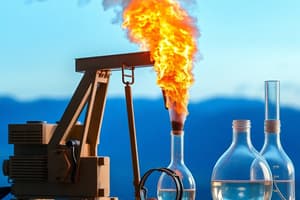Podcast
Questions and Answers
What is the main consequence of a higher compression ratio in an engine?
What is the main consequence of a higher compression ratio in an engine?
- More power can be provided (correct)
- Knocking is eliminated
- Less energy is conserved
- Fuel efficiency is decreased
What is the primary cause of knocking in an engine?
What is the primary cause of knocking in an engine?
- Spark plug malfunction
- Ignition of the fuel mixture before the spark plug fires (correct)
- High fuel efficiency
- Low compression ratio
What is the first law of thermodynamics also known as?
What is the first law of thermodynamics also known as?
- The law of fuel efficiency
- The law of conservation of energy (correct)
- The law of energy transformation
- The law of energy conservation
What is the result of transforming thermal energy into ordered work?
What is the result of transforming thermal energy into ordered work?
What is the purpose of blending branched alkanes with fuel?
What is the purpose of blending branched alkanes with fuel?
What is the main limitation of increasing the compression ratio in an engine?
What is the main limitation of increasing the compression ratio in an engine?
What is the result of the second law of thermodynamics?
What is the result of the second law of thermodynamics?
What is the relationship between the compression ratio and power output in an engine?
What is the relationship between the compression ratio and power output in an engine?
What is the energy required to break the C-H bond?
What is the energy required to break the C-H bond?
Which fuel has the highest Lower Heating Value?
Which fuel has the highest Lower Heating Value?
What is the main difference between the Lower Heating Value and the Higher Heating Value?
What is the main difference between the Lower Heating Value and the Higher Heating Value?
Which of the following fuels has the highest energy density?
Which of the following fuels has the highest energy density?
What is the bond energy of O=O?
What is the bond energy of O=O?
Which of the following fuels is a type of alternative fuel?
Which of the following fuels is a type of alternative fuel?
What is the Higher Heating Value of Hydrogen?
What is the Higher Heating Value of Hydrogen?
Which of the following fuels has the lowest Lower Heating Value?
Which of the following fuels has the lowest Lower Heating Value?
What is the primary function of a fuel?
What is the primary function of a fuel?
How do fuels generate energy?
How do fuels generate energy?
What determines the energy value of a fuel?
What determines the energy value of a fuel?
What is the relationship between the First and Second Laws of Thermodynamics and energy production from fuels?
What is the relationship between the First and Second Laws of Thermodynamics and energy production from fuels?
What is the purpose of the octane number?
What is the purpose of the octane number?
What is the classification of fuels based on their physical state?
What is the classification of fuels based on their physical state?
What is the term for a reactant that limits the whole chemical reaction?
What is the term for a reactant that limits the whole chemical reaction?
What is the significance of the 0.19 moles of oxygen used in combustion?
What is the significance of the 0.19 moles of oxygen used in combustion?
Flashcards are hidden until you start studying
Study Notes
Fuels and Energy Relationships
- A fuel is a substance that can be used as a source of power.
- Fuels can be classified into:
- Solid fuels
- Liquid fuels
- C–H (hydrocarbon) fuels
Calorific Values of Fuels
- Calorific values are the energy values of fuels.
- The Lower Heating Value is calculated with the product of water being in vapor form.
- The Higher Heating Value is calculated with the product of water being in liquid form.
- Examples of calorific values of different fuels:
- Biodiesel: 119,550 - 127,960
- Propane (LPG): 84,250 - 91,420
- Compressed Natural Gas (CNG): 20,160 - 22,453
- Liquified Natural Gas (LNG): 21,240 - 23,726
- Ethanol: 76,330 - 84,560
- Methanol: 57,250 - 65,200
- Hydrogen: 51,585 - 61,013
Octane Number and Engine Knocking
- Octane number is a measure of a fuel's resistance to knocking.
- Knocking is a rapid pinging or knocking sound that comes from an engine when it is pushed to produce a lot of power quickly.
- Knocking can result in a loss of power, inefficiency, and fractures in the top surface of the piston.
Thermodynamics and Energy Production
- The First Law of Thermodynamics: Energy is conserved and transformed from one form to another.
- The Second Law of Thermodynamics: The entropy of the universe is increasing.
- The relationship between the First and Second Laws of Thermodynamics and energy production from fuels.
Studying That Suits You
Use AI to generate personalized quizzes and flashcards to suit your learning preferences.




